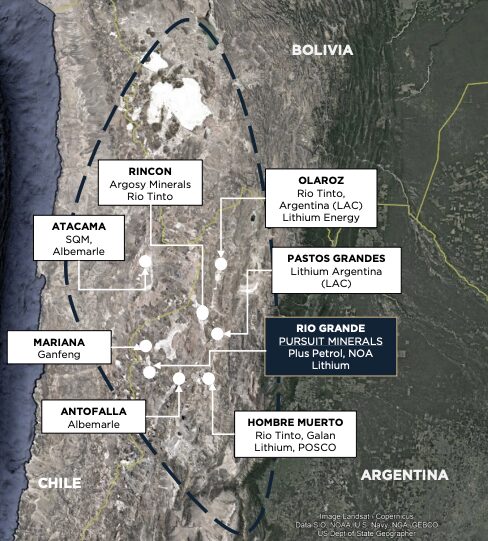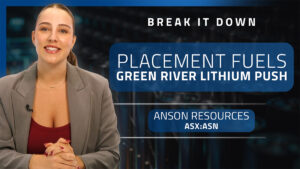Jurisdiction Spotlight: Opportunistic buying places Argentina as front-runner in Lithium Triangle

Argentina is outpacing rivals in the Lithium Triangle. Pic: Getty Images
- As supply chain risks mount in Asia, Argentina is cementing its status as Latin America’s premier lithium destination
- POSCO’s $62m bid for Lithium South’s Hombre Muerto assets highlights the country’s growing appeal
- Pursuit Minerals’ Aaron Revelle says POSCO’s move for Lithium South backs what he’s been saying all along – Argentina is now the Lithium Triangle’s top draw
Argentina is rapidly establishing itself as Latin America’s most attractive lithium investment destination, drawing major international capital as Asian supply chains face mounting disruptions in the wake of CATL’s decision to suspend operations at its Jianxiawo lithium mine.
The latest example comes from South Korean giant POSCO and its $62m cash offer (A$92m) for Lithium South Development Corp’s exploration assets in Argentina’s Hombre Muerto Salar, the largest and longest producing lithium salar in the country.
Investor enthusiasm drove a 50% increase in Lithium South’s share price, jumping from 20c to 30c in the aftermath, highlighting Argentina’s growing status as the leading destination for lithium mining within Latin America’s Lithium Triangle.
More than 50% of the estimated global lithium resources and 40% of current world production is located in the salt flats of Chile, Argentina and Bolivia, known as the Lithium Triangle.
Argentina holds the world’s second largest lithium resources and is currently the world’s third largest lithium producer behind Australia and Chile.
Argentina’s rise as Lithium Triangle leader
Pursuit Minerals (ASX:PUR) managing director Aaron Revelle has been vocal about the shift from Chile to Argentina as the Lithium Triangle’s premier lithium destination, a view he says is now further backed by POSCO’s recent bid for Lithium South.
“Over the last five to ten years, there’s been a lot of consolidation on that salar, where now you have three operators including POSCO, Rio Tinto, which is consolidated through the Fenix project and controls most of the salar, and then you’ve got Galan which is towards the northwest margin of the salar,” he told Stockhead.
“Five years ago, there were about five to six operations in Hombre Muerto and when you compare the economics of Lithium South Development Corp’s market cap to the offer, the company was trading at $10m a couple days before hand, with POSCO offering a six to seven times premium.
“There’s only a few salars in Argentina left that haven’t been consolidated.
“Argentina is obviously incentivising investment through initiatives like RIGI, scrapping export taxes and currently controls, making it generally an easier place to operate in.”
Consolidation and acquisitions
And there’s even more consolidation taking place in the region with China’s Ganfeng Lithium and Switzerland-based Lithium Argentina agreeing to merge their assets into a single large-scale lithium operation last week.

The newly formed PPG joint venture brings together Ganfeng’s wholly owned Pozuelos–Pastos Grandes project with Lithium Argentina’s majority stakes in the Pastos Grandes (85%) and Sal de la Puna (65%) projects.
Designed to scale up in three phases, the merged project aims for annual production of 150,000t of lithium carbonate equivalent.
The pace of acquisitions in Argentina is in stark contrast to the situation in Chile, where CleanTech Lithium was recently denied a Special Lithium Operating Contract (CEOL) for its Laguna Verde project.
Shares in the AIM-listed company, which holds the dominant licence position on the Chilean side of the Lithium Triangle, dropped ~30% as a result.
“They now have to go through a public tender process, which means lots of bureaucracy, red tape and bottlenecks,” Revelle said.
“Argentina doesn’t have that. The POSCO offer shows that even in a depressed market of sub-US$10,000 per tonne prices, lithium projects in the country are still attracting significant premiums.”
There’s more where that came from.
Back in April, Galan Lithium (ASX:GLN) rejected a US$150m (A$240m) cash offer from China’s Zhejiang Huayou Cobalt Co and France’s Renault Group to acquire its Hombre Muerto West and Candelas lithium brine projects in Argentina.
The board deemed the offer opportunistic and has recently secured funding to move Hombre Muerto West through to Phase 1 production.
“At the end of the day, there isn’t much supply in terms of actual salars that companies can get into, the majority of them are gone. So for those that still own these projects there should be a premium price, because in five years’ time, deals like that won’t be able to be done,” Revelle said.
Is a lithium boom brewing?
Revelle believes this opportunistic buying could be a sign a lithium boom is on the horizon and believes we’ll see a more balanced market come 2028-2030.
The market was given a taster of how volatile the run up in prices could be once that balance shifts, with only a couple of mine shuts in China sending spodumene prices (the hard rock concentrate made in Australia) storming from under US$700/t to US$1000/t in recent weeks.
“Investors are getting into position now in anticipation that supply is limited,” he said.
“There are only a few projects around that are good, tier-1 operating assets, and by tier-1 we’re talking a chemistry profile where the brine is over 400mg/l Li, showing proof of production.
“Rio Grande Sur has produced lithium at a 99.5% technical grade, and that’s what everyone is after,” Revelle added.
“Demand is meant to hit 3 million tonnes in 2030 but where is everyone going to get these assets? Consolidation is needed and will happen and people will be positioning ahead of that expected rebound.”
At Stockhead, we tell it like it is. While Pursuit Minerals is a Stockhead advertiser, it did not sponsor this article.
Related Topics

UNLOCK INSIGHTS
Discover the untold stories of emerging ASX stocks.
Daily news and expert analysis, it's free to subscribe.
By proceeding, you confirm you understand that we handle personal information in accordance with our Privacy Policy.








